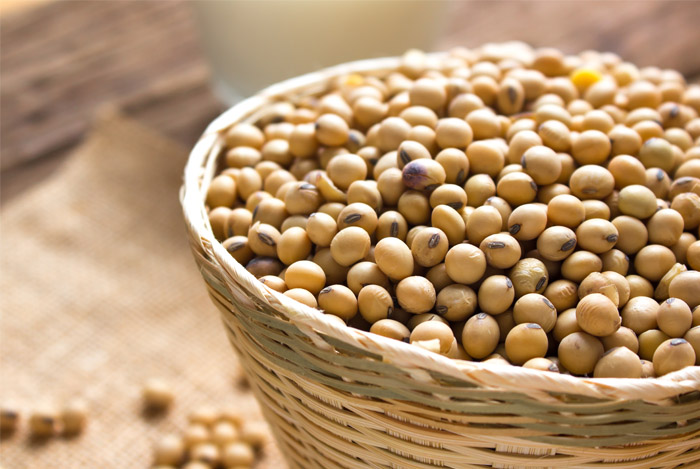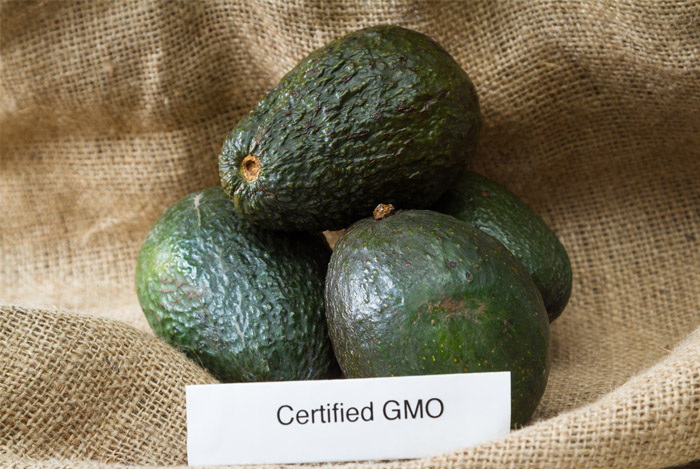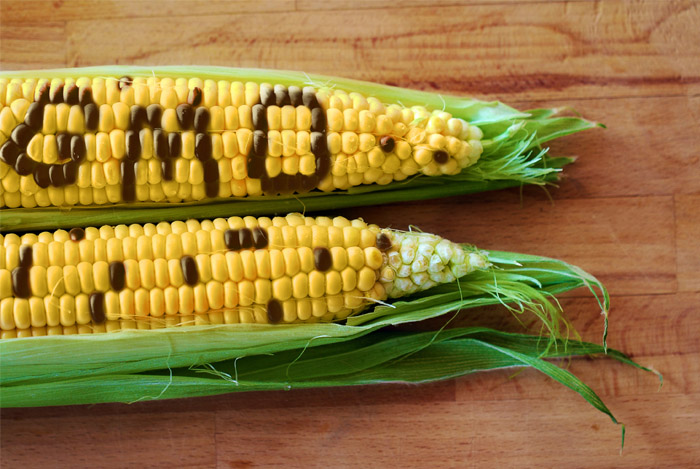Genetically modified (GM) food is one of the most controversial subjects in the US today.
Foods that have been genetically engineered have had foreign genes (from other plants or animals) inserted into their genetic codes.
You may have heard about some of these alleged hybrids and thought they came out of a science fiction book – like GM goats with spider-web-like milk stronger than Kevlar, or engineered salmon that continue to grow larger.
But the truth is, in real life, GM foods are far less conspicuous than that. In fact, many people are unaware that we’ve been eating them since 1994 when the first ‘Flavr-Savr’ tomato went on sale.
While the tomato was deemed a bit of a flop, since then genetically modified papaya, zucchini, corn, soy, canola and more have all come on the market. In the next few years, we’ll be able to buy apples that don’t brown and potatoes that don’t bruise.
Sure, these engineered foods sound pretty innocuous but are they really safe? That’s what I’m going to look at in this article.
Are GM Foods Nutritious?
 Monsanto, one of the biggest producers of GMOs (genetically modified organisms), says that their GM crops are as nutritious as their conventional counterparts. In fact, they claim that some of their crops are even more nutritious – such as their high-oleic soybean oil.
Monsanto, one of the biggest producers of GMOs (genetically modified organisms), says that their GM crops are as nutritious as their conventional counterparts. In fact, they claim that some of their crops are even more nutritious – such as their high-oleic soybean oil.
Oleic acid is a heart-healthy monounsaturated fatty acid that’s also found in olive oil, avocados and even dark chocolate.
What’s more, certain foods are being specifically modified to address nutritional deficiencies. Take golden rice for example, a rice that has been altered to contain beta-carotene, a substance that the body can convert into vitamin A.
It’s not yet on sale but GM companies say it will help combat vitamin A deficiency in developing countries – despite opposition from Greenpeace who say that the money spent developing golden rice could better be used to address these deficiencies in more sustainable ways.
A study published in 2012 showed that the beta-carotene in golden rice was just as effective at alleviating vitamin A deficiency in children as supplements, and was more effective than spinach.
Just 150 grams of the rice was found to provide 60% of the daily requirement of vitamin A.
I should mention that the study was retracted in July 2015 following two years of controversy surrounding the ethics of testing on children, although the findings are still thought to stand.
However, other studies comparing GM, non-GM and organic foods have found that biotech crops rank last in terms of nutrition.
For example:
- In a comparison of organic, conventional and GM soybeans, it was found that the GM beans were nutritionally inferior to the organic ones, providing less protein, zinc and fiber; but more saturated fat and omega 6 fatty acids.
- A 2012 analysis of GM and conventional corn found that the non-GM corn had 437 times more calcium, 56 times more magnesium and 7 times more manganese.
Based on these findings, it’s hard to say for sure whether the GM crops currently for sale are less nutritious than their conventional equivalents, although some results certainly show this is the case.
Do GMOs Cause Illness?
 There is huge debate around the potential health effects of GMOs, and with good reason. They’ve only been available for human consumption for two decades, so the long-term health effects are not yet known.
There is huge debate around the potential health effects of GMOs, and with good reason. They’ve only been available for human consumption for two decades, so the long-term health effects are not yet known.
However, there have been more than 2,000 studies carried out that have found GM foods are safe for either human health or the environment – echoing everything the biotech industry has said from the beginning.
What’s more, a review of the literature published on GMOs in 2011 found that there is no evidence that GMOs cause harm in humans.
But the authors of the paper also state that, prior to 2006, there were very few studies concerning human and animal health risks. While studies increased dramatically from 2006, they didn’t focus on newer biotech products.
They also say that “most of these studies have been conducted by biotechnology companies responsible for commercializing these GM plants” – in other words, they are completely biased
On the opposite side of the argument for the safety of GMOs, there are studies that show adverse health effects of consuming these foods.
- GM corn fed to rats negatively affected the kidneys and liver, two of the body’s main detoxifying organs; along with the heart, adrenal glands, spleen and blood cells.
- GM soy has been linked to pancreatic problems in animal studies.
- A controversial study that was retracted due to commercial pressures and then republished, found that the herbicide Roundup (routinely used on GM crops) caused serious hormone disruption – something that could be particularly harmful to developing children.
Clearly, the number of studies showing GMOs have no effects on human health far outweigh the studies showing adverse side-effects.
However, experts like Sheldon Krimsky (professor of Public Health and Community Medicine at Tufts Medical School in Boston) says that as we evaluate the safety of GMOs these few dozen studies showing risks should “carry more weight”.
Do GMOs Expose Us To Herbicides?
 It’s true that certain GM crops have been engineered to withstand Monsanto’s patented herbicide Roundup – meaning farmers can liberally spray their crops with powerful chemicals while only killing the weeds, not the corn or soy. These crops are known as ‘Roundup-Ready’.
It’s true that certain GM crops have been engineered to withstand Monsanto’s patented herbicide Roundup – meaning farmers can liberally spray their crops with powerful chemicals while only killing the weeds, not the corn or soy. These crops are known as ‘Roundup-Ready’.
Monsanto says that Roundup is as safe to humans as aspirin. The World Health Organization says its active ingredient, glyphosate, is “probably carcinogenic“.
A paper, published in 2013 in the journal Entropy, discussed the health effects of glyphosate exposure. The authors say it causes inflammation and disrupts gut bacteria, which can lead to “gastrointestinal disorders, obesity, diabetes, heart disease, depression, autism, infertility, cancer and Alzheimer’s disease”.
But is this chemical getting into our systems?
In the comparison of organic, conventional and GMO soybeans I mentioned earlier, residues from Roundup were found on the GM soybeans but not on the other two, indicating that eating GMOs can expose us to glyphosate.
We may not even need to eat these engineered foods to be exposed.
A report on the levels of glyphosate in the air and rain water of Iowa and Mississippi was published in the journal Environmental Toxicology and Chemistry in 2011. Glyphosate was detected in 60% to 100% of all air and rain samples tested.
Other tests, carried out in Catalonia in Spain, found that over 40% of groundwater samples tested positive for glyphosate.
And, when urine samples were analyzed at the Medical Laboratory Bremen in Germany, 44% of the samples tested, from people in 18 countries across Europe, were found to contain glyphosate.
Other reports say this chemical has been detected in human blood and even breast milk.
It’s clear that biotech foods expose us to far more pesticides than organic or even conventional crops do. What’s more, it seems that chemicals from these pesticides have found their way into our water supply and bodies.
Do GMOs Impact The Environment?
 The impact of GM foods on the environment is also of huge concern. In addition to our air and water being filled with traces of glyphosate, GMOs threaten our environment in other ways.
The impact of GM foods on the environment is also of huge concern. In addition to our air and water being filled with traces of glyphosate, GMOs threaten our environment in other ways.
Firstly, pollen from GM crops has been found to have contaminated nearby crops and wild plants.
In North Dakota, genetically modified canola was found growing in the wild. In Mexico, heritage corn crops have been cross-pollinated with the biotech variety.
This type of pollination is carried out by insects, so it’s practically impossible to stop. If all our non-GM crops become contaminated with the Roundup-Ready varieties, it could have a serious impact on our flora and fauna.
Secondly, biotech crops are helping to breed ‘super-weeds’ that can withstand chemical exposure. By 2011, there were three times as many herbicide-resistant weeds found in farmer’s fields as there were in 2001.
Thirdly, contrary to what biotech companies promised (less instead of more chemical use), our environment is being subjected to even more herbicides and pesticides than ever. According to USDA and EPA data, the adoption of GM crops has increased herbicide use over the past decade in the US.
Finally, GM crops could eradicate organic farming through cross pollination and contaminated groundwater. In fact, one in three organic farmers have already dealt with contamination on their farm.
As you can see, GM crops impact the environment in a number of ways. What I find most concerning is the cross pollination of GM crops with wild and even organic crops.
As this process can’t be reversed, it leads me to worry that organic farming may not even be possible in the future, when GM crops grow in popularity.
How Common Are GMO Foods?
 More common than you’d think!
More common than you’d think!
It’s estimated that up to 80% of processed foods in the US contain GM ingredients.
Some of the most common biotech crops produced in the US include:
- Soy beans – almost 95% of which are GM, according to USDA figures.
- Corn – over 90% of which is GM.
- Sugar beets – 95% of which are GM – and approximately half of all sugar comes from beets.
- Canola – 90% of which is GM.
Other GM crops include alfalfa, cottonseed, zucchini and Hawaiian papayas. The FDA has also recently approved the production of both biotech potatoes and apples, expected to be on sale as early as 2017.
GMO Food Labels
 So, if the above concerns you, you may want to know how you can spot GM foods. What labels do they carry?
So, if the above concerns you, you may want to know how you can spot GM foods. What labels do they carry?
The answer? None!
Due to US labeling laws GM foods, or foods containing GM ingredients, don’t need to be marked as such. This is despite strong public opinion that believes they should be clearly marked.
In a recent poll conducted by ABC News, a staggering 93% of people believe that GM foods should be labeled.
Barely more than a third of those polled believe that GM foods are safe to eat, 52% think they are unsafe and another 13% are unsure. And 57% say they’d be less likely to buy foods labeled as GM.
The only way to be sure that you’re not eating a biotech product is to steer clear of processed foods, and look for labels that state ‘USDA Certified Organic’ or ‘Non-GMO Project Verified’ – although, of course, not all non-GMO foods will carry these labels.
Final Thoughts
 As GMO foods have only been around for two decades, it’s hard to say for sure if they really are ‘the enemy’.
As GMO foods have only been around for two decades, it’s hard to say for sure if they really are ‘the enemy’.
One thing is for sure, there is enough information out there to justify public concern around their health and environmental impacts, even if the industry and government refuse to take people’s fears seriously by introducing mandatory labeling.
As far as I can see, cutting out processed foods is one huge step you can take to avoid eating GMOs – these products are almost always loaded with engineered soy, canola and corn.
Besides GMOs, processed foods contain tons of sugar and other questionable ingredients. I’d go so far as to say that eliminating these foods is one of the best steps you can take to clean up your diet.
Perhaps in years to come, more definitive research will emerge showing the true implications, whether good or bad, of consuming genetically modified foods.
For now, we can only use our best instincts to guide us when it comes to choosing whole, nutritious foods to fuel our bodies.
Where do you stand on the issue of GMOs? Let me know your thoughts!
The post Are GMO Foods Really the Enemy? appeared first on Nutrition Secrets.
http://www.nutritionsecrets.com/are-gmo-foods-really-the-enemy/
This comment has been removed by the author.
ReplyDeleteThis comment has been removed by the author.
ReplyDelete